Marking time in November 2003
Doggy-do bags
Last year, my sister Fiona commented here: Our local dog-friendly park provides doggy-do bag waterproof receptacles. This is a refreshing alternative to sharps containers… Each doggy-do bag contains a handy rectangle of cardboard for use as a scraper. Whether you want it or not, I will send you one. An unused one, be assured.
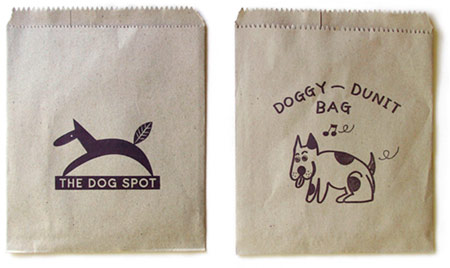
Fiona has come for a visit, bringing two samples — perhaps the basis for a collection. What can I say.
Charles Cushman photographs
Charles Weever Cushman, amateur photographer and Indiana University alumnus, bequeathed approximately 14,500 Kodachrome color slides to his alma mater. The photographs in this collection bridge a thirty-two year span from 1938 to 1969, during which time he extensively documented the United States as well as other countries.
The university’s digital library program has scanned the pictures and published them on the web. Cushman was a skilled amateur, armed with a Contax rangefinder camera and, it seems, an inclination to record the things around him. Worth a look.
!['Haight Street two hippies', 14 March 1968, San Francisco [image from the website]](images/hippies.jpg)
Cabinets of curiosities
I’m grateful to Caterina for pointing out the website Cabinets de curiosités. If you understand French you can read about weird collections of objects from the time before museums became public institutions. If French is a foreign language to you, just look at the pictures or use google to translate.
Message from Alaska
For recreation I read a mailing list devoted to old woodworking tools. There is constant banter about hand-forged chisels, the shapes of saw handles, infill planes, tool patents, and many other subjects. The members are almost all men, and mostly in the older age bracket. The discourse is helpful, erudite, relaxed and polite. Nobody swears or insults anyone.
This is a quirky crowd, and I enjoy visiting workbenches and toolchests all over the world. Some messages take me right away from the places I know. Like this one from Phil Koontz in outback Alaska, headed ‘That ol’ commute’:
Hi Galoots —Well, we finished the walls of our log cabin over a month ago. It turned out to be 10½ courses high — 10 logs for the side walls and 11 logs on the front and back. That’s a bit taller than I planned, but it was more or less required to get the front wall header high enough for the door frame.
Since then, we haven’t even visited the place out of deference to ice chunks floating down the river. The freezeup this year has been kind of a slow process on the Yukon. I pulled our boat out of the water in early October, and the ice has been running for more than four weeks. It still hasn’t stopped, and there isn’t really any snow to open up the snowgo trails yet, but another transportation route opened up this week.
The overland trail is 12 miles or so. About half of that is a more-or-less public road. The next three or four miles is a Cat trail that our neighbor opens to his cabin when the wetlands freeze over, and that finally happened. The rest of the way is a trail along the river bed through Bessy Slough and Louden Slough. That trail usually isn’t there, but it was revealed this year when the river went way down. So I guess the construction season is open again.
Yesterday Karin and I drove out there with a picnic and four dogs, and we hope to get back today. If the weather don’t turn cold (it’s been around 0 F lately, but the prediction is maybe -50 for the weekend), the whole crowd SWMBO Debbie, our friend Karin and me) hope to camp out for the weekend and maybe finish up the gable ends and purlins. It’s kind of an erie trip now, because we got accustomed to travelling by boat last summer, and now we are driving part of the same route in my old pickup. As we worked yesterday, Karin and I occasionally glanced down the hill to snicker about the truck parked at the boat landing.
The roof design has been a long series of quandaries and plan changes. We would really like to have a cold roof, which means that air circulates between the insulation and the roofing. And I would like to have about a 4:12 or 5:12 roof pitch to help shed snow. So we keep tossing back and forth between roof trusses, purlins and ridgepole, and log or framed gable ends. There are several problems with any of the approaches, including logistics. One of them is simply an issue of getting hold of lumber for the rafters and roof stringers in a small town—the sawmill owner is having problems getting a baby sitter.
Another issue is that I hurt my back rassling one of those last big wall logs, so I’ve been extra careful messing around on top of icy walls with ladders and sharp tools.
OT content — pretty skimpy I’m afraid. I’ve already told you about scribing logs, although it was a bit different yesterday because all summer I was using squirt bottles to wet the logs so my pencil lines will show up. Turns out that doesn’t work too good any more. There is some stuff I could go into about log psychology — Karin calls it everyday physics. For each stage of the project, we have developed tricks and techniques for handling the big sticks, and as the work gets closer to the limits of the hand crane, our techniques have been changing a little. The crane won’t quite let us set the logs where we want them for the end walls, so we have always had to park them diagonally across a corner of the wall, then skid/roll/levitate them across to the far side wall. As the gable ends are building up now, that distance is getting less, and the logs are getting shorter and easier to handle. But now the height of the crane is becoming a factor. Limits. Production planning. Operations management. What to take for lunch. Those executive decisions we all know and love.
PK
Galena Alaska
As well as a log cabin builder, Phil Koontz is a blacksmith. His website displays some of the stuff he makes — if you need some brackets to hold a pair of pre-historic mammoth tusks, he’s the bloke for the job.
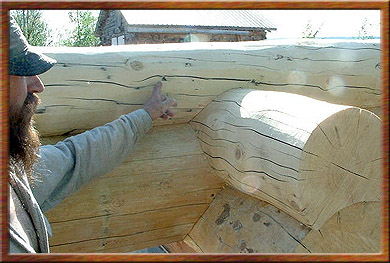
Over the top
For Remembrance Day, a reminder that arguments about the authenticity of the photographic record are not new.
Frank Hurley, in France with the Australian troops in 1917, wrote about the problems of recording what was going on around him:
I have tried, and tried again, to include events on a single negative but the results have been hopeless. Everything is on such a wide scale … Figures scattered, atmosphere dense with haze and smoke—shells that simply would not burst when required. All the elements of a picture were there, could they but be brought together and condensed. The battle is in full swing, the men are going over the top—I snap. A fleet of bombing planes is flying low, there is a barrage bursting all round. But on developing my plates there is disappointment. All I find is a record of a few figures advancing from the trenches and a background of haze.
!['Very large print of Over the Top, a composite shot of World War I battle in Ypres, signed Frank Hurley 1917, propped against a house' [nla.pic-an23478249]](images/OverTheTop.jpg)
Frank Hurley’s controversial answer to this problem was to combine multiple images into a single composite print. I’ll quote from Lennard Bickel’s book ‘In search of Frank Hurley’ (Melbourne, Macmillan, 1980):
Hurley burned with eagerness to display the lives of ‘our boys’ for their people at home but at the same time he was ‘sick of being among the dead and the suffering men’ and this fed his disillusion with high command and led him into his ‘great argument’ with Charles Bean, telling the historian again, and again—’It is impossible to secure full effects of this bloody war without composite pictures.’ It won him no ground; Bean was backed from on high and Hurley was complaining through the bitter fighting of September 1917 that army authority had restricted him—’…I am not even allowed to insert clouds!’
It took a hard campaign—and a threat to resign as Australia’s official war photographer—before the army allowed Hurley to make a series of composite pictures for exhibition. ‘Over the Top’ is perhaps the best-known and most controversial of these.
Kristallnacht
On the night of 9 November 1938 terror attacks were made on Jewish synagogues and stores in Germany. Kristallnacht ( ‘night of broken glass’) was the start of the Nazi campaign against the Jews.
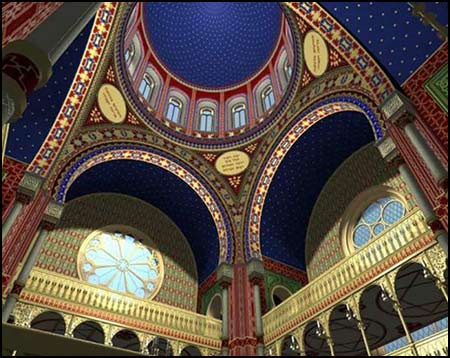
My special places selection for this month is a project to make digital reconstructions of synagogues destroyed on kristallnacht. Thanks to Volker Weber for pointing this out.
Fiona Gardiner: it’s your birthday!
Which prompts me to scan and share this newspaper clipping from The Australian of 15 November 1974. On the left is a story about a campaign by Fiona Gardiner and Helen Wilson to conserve the works of the South Brisbane Gas Co. On the right is a piece about the area that would later become Cooloola National Park.
Back then Jo Bjelke-Petersen was the staunchly pro-development Premier of Queensland. Gough Whitlam was the Prime Minister and the National Estate Inquiry had recently reported. The Australian Heritage Commission Act was still in the future. To suggest conserving a gas works was the business of ratbags.
Now it’s become — like us perhaps — respectable, sort of.
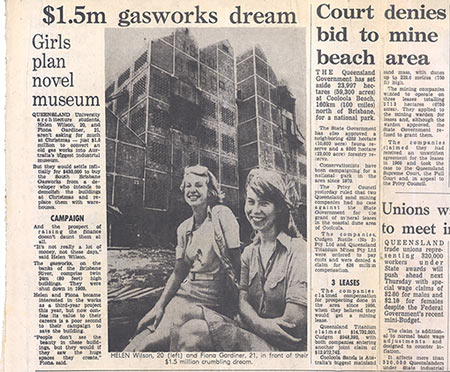
Here’s the text of the gasworks piece:
$1.5m gasworks dream: Girls plan novel museumQueensland University architecture students, Helen Wilson, 20, and Fiona Gardiner, 21, aren’t asking for much at Christmas — just $1.5 million to convert an old gas works into Australia’s biggest industrial museum.
But they would settle initially for $430,000 to buy the South Brisbane Gasworks from a developer who intends to demolish the buildings at Christmas and replace them with warehouses.
Campaign
And the prospect of raising the finance doesn’t daunt them at all.
“It’s not really a lot of money, not these days,” said Helen Wilson.
The gasworks, on the banks of the Brisbane River, comprise twin 24m (80 feet) high buildings. They were shut down in 1969.
Helen and Fiona became interested in the works as a third-year project this year, but now confess its value to their career is a poor second to their campaign to save the building.
“People don’t see the beauty in these buildings, but they would if they saw the huge spaces they create,” Fiona said.
[picture caption: Helen Wilson, 20 (left) and Fiona Gardiner, 21, in front of their $1.5 million crumbling dream.]
Harriett Brims, photographer
My congratulations to the Picture Queensland crew at the State Library of Queensland for adding a collection of photographs by Harriett Brims to their digital collection.
The project news page has a short biography and introduction to the photographer’s work, written by Dianne Byrne, with thumbnail links to some of the photographs. If that page has gone by the time you read this, just search* Picture Queensland for “Harriett Brims”.
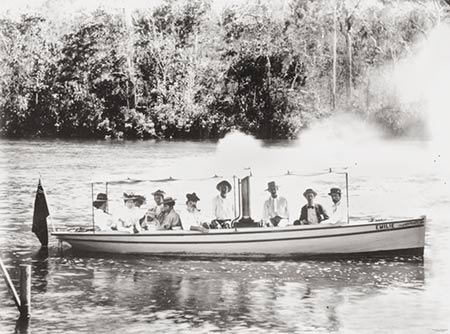
From Dianne Byrne’s introduction:
Harriett Pettifore Brims (1864-1939), professional photographer, was born at Yandilla, Queensland, in 1864, daughter of William Elliott, a station owner, and Ann Jane, nee Faulks. In November 1881, at Blackall, she married Donald Gray Brims, an engineer from Caithness in Scotland; between 1882 and 1890 she gave birth to five children. In about 1894 the family moved to Ingham, where Donald Brims constructed a homestead with an adjoining sawmill and wharf near the mouth of the Seymour River. Within a few years Harriett Brims had established herself professionally as a photographer.
Harriett’s photographs record the Brims family at work in sawmilling, joinery, boatbuilding, and even aeroplane construction.
Her photographs were taken with dry-plate cameras manufactured by her husband, himself an enthusiastic operator. They were made from the local maple-wood he harvested, and fashioned in his workshops. He also made her camera shutters—from sheet brass recovered from opium tins discarded by the district’s Chinese workers—and cow-hide carrying cases which she used to transport her equipment. Her subjects ranged from the Melanesian labourers who were transported to live and work in the northern canefields to views of the Gairloch and Macknade sugar plantations, the copper smelters of Chillagoe, and landmarks such as Wallaman Falls, near Ingham.
I am delighted to discover this body of work of an unknown (to me) pioneer woman photographer, nicely connected with places and activities close to my heart.
*<irony> I think the Picture Queensland database server might have a flat battery, or perhaps its clockwork needs to be wound up.</irony> Be patient, the results are worth waiting for.
Damnation dog
My daughter Sally (4 ¾ years old) made this drawing. I said, “Oh, I like that spotted dog! What sort of dog is that?” She said, “It’s a damnation”.
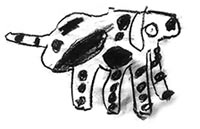
Telling tales: the poster
I have made a poster for the telling tales conference, to illustrate the points I raised yesterday. Its a bunch of pages from this site displayed as if in open browser windows, lined up to speak for themselves.
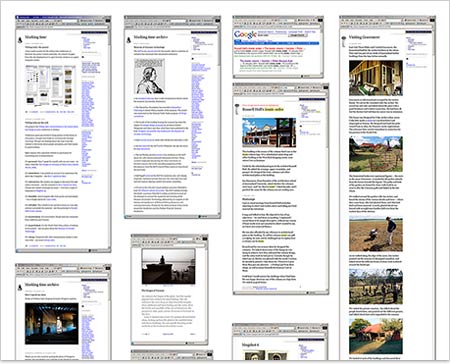
Telling tales on the web
I’m going to the Australia ICOMOS Telling tales: interpretation in the conservation and design process conference in Sydney.
Conference-goers are invited to bring posters on the theme of innovative concepts and media to communicate heritage meanings. This got me thinking about the ways I use this website to tell stories about people and places, and what makes it a good medium.
Eight reasons why a personal website is a good place for committing acts of interpretation:
It’s personal. Here I speak for myself, with my own voice — as when I describe The Ganges at Varanasi, or Hotel room, Chandi Chowk, Delhi.
It’s immediate. I can publish an account of an experience the same day it happens — see How I spend my days.
It’s interactive. My readers can engage in discussion through online comments — see the comment to How I spend my days. (People also initiate exchanges by email — I’ve had a couple of responses to Mugshot 4).
It’s findable. Search engines offer both power and serendipity — try a Google search for ironic order.
It’s editable. This website is not carved in stone, so I can add, subtract and polish the material — see the postscript to Russell Hall’s ironic column.
It’s locationless. It’s everywhere. People send me comments from California, and Caracas.
It’s hyperlinked. It’s the World Wide Web, a fabric of millions of documents — see my piece about the Museum of Jurassic Technology.
It’s cheap. Compared with other interpretation media it costs very little — see some hosting rates.